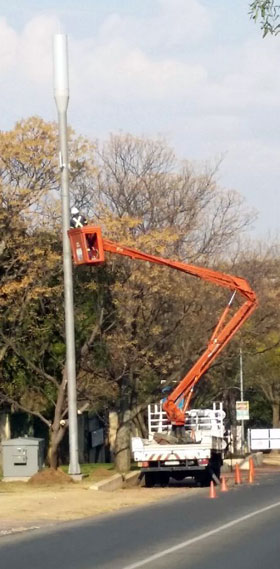
MTN South Africa has secured a tender from City Power, Johannesburg’s electricity supply agency, to turn lampposts into cellular base stations in a move the operator believes will go a long way to solving coverage challenges not only in South Africa’s largest city but across urban South Africa.
In the past week, the mobile operator has deployed the first two such towers in the leafy suburb of Bryanston, with more than 100 more to follow before Christmas, its chief technology officer, Eben Albertyn, tells TechCentral.
Albertyn says that through its deal with City Power, MTN is entitled to replace any of the approximately 110 000 lampposts throughout the greater Johannesburg region with this specially designed base station infrastructure. It is the only mobile operator that has permission from City Power to replace Johannesburg’s lampposts and is now in discussions with municipalities elsewhere around South Africa about extending the project to other cities.

When MTN identifies a site that needs better coverage, the company literally replaces the entire lamppost with a new, much stronger pole, which is made of thick, reinforced steel and which integrates the base station equipment, including the radio apparatus. It is then hooked up to electricity and to fibre backhaul, which MTN will supply. Naturally, the lamppost still provides street lighting. Only a trained eye would recognise that it’s not simply a lamppost, says Albertyn.
In terms of the City Power deal, MTN may only use local pole manufacturers that have been approved by the City of Johannesburg. The poles are designed to withstand even the strongest gale-force winds and are earthed and their equipment shrouded to protect them from lightning. However, if lightning destroys a site, MTN will immediately replace the equipment, says Albertyn.
The operator pays a monthly fee to City Power for each the sites it deploys. Constructing a site takes 11 hours from start to finish – this is significantly quicker than building a traditional base station, he adds.
Albertyn says he expects some residents will be unhappy with the concept, but he says MTN has no choice if it’s going to extend coverage to everyone. He says he residents should be “assured that MTN has gone through all the proper channels to make sure it has obtained and is compliant with all health and safety regulations, as well as by-laws — both at a council and a national level”.
The project will also bring fibre closer to people’s homes, he says. This will play an important part in MTN’s broader plan to roll out home fibre in South Africa and will also help communities install security camera infrastructure in their neighbourhoods. “There will be some fallout [from unhappy consumers], but the benefits are massive,” he says.
MTN intends deploying about one lamppost base station a day for the rest of the year as part of phase one of the project. By Christmas, it will have more than 100 such towers in place in areas such as Bryanston, Sandton, Woodmead, Northcliff, Westcliff, Kyalami and Fairland. It is specifically focusing on areas where its 3G and 4G/LTE coverage needs improvement. — © 2014 NewsCentral Media




